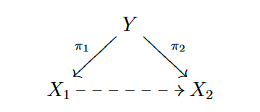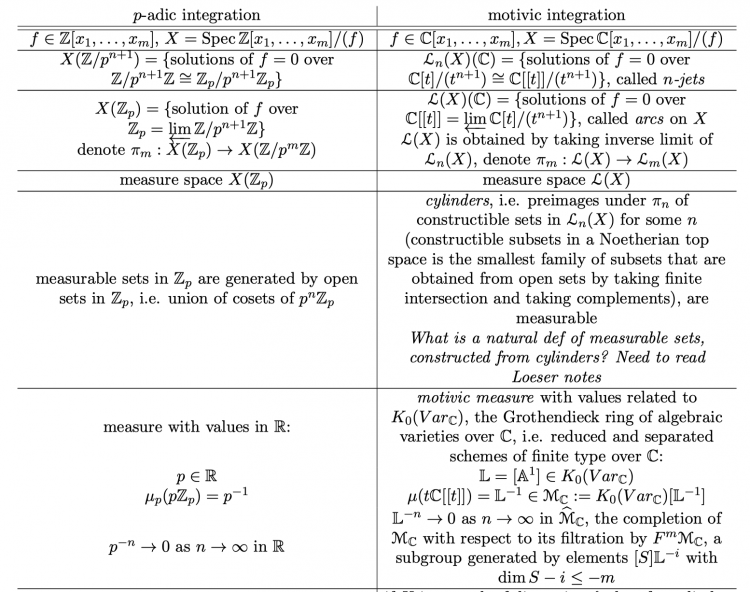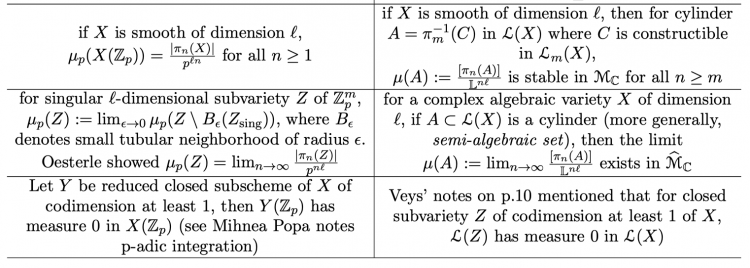In this topic, I introduce the notion of the so-called motivic integration, which is an upgrade version of the old version, namely, the p-adic integration. The word motivic literally means the values of this integration is essentially geometric. It was introduced by M. Kontsevich in his lecture in Orsay in 1995 to solve a theorem of Bartyrev stating that two birational Calabi-Yau varieties have the same Betti numbers.
Let $S$ be a scheme. By a $S$-algebraic variety, we mean a $S$-scheme of finite presentation. We denote by $\mathrm{Var}_S$ the isomorphism classes of finite presentation $S$-schemes. When $S = \mathrm{Spec}(k)$ with $k$ a field, we simply write $\mathrm{Var}_k$ instead of $\mathrm{Var}_{\mathrm{Spec}(k)}$.
Jet scheme and arc space
Let $X$ be a $k$-variety.
Proposition 1. For $m \in \mathbb{N}$, there exists an algebraic $k$-variety $J_m(X)$ such that:
\begin{equation*}
\mathrm{Hom}_k(Z \times \mathrm{Spec}(k[t]/(t^{m+1})), X) \simeq \mathrm{Hom}_k(Z,J_m(X))
\end{equation*} for any $k$-scheme $Z$.
Proof. It is sufficient to deal with the case $X, Z$ are affine, i.e., $X = \mathrm{Spec}(R)$ and $Z = \mathrm{Spec}(A)$ for some $k$-algebra $R$ and some finitely generated $k$-algebra $R = k[x_1,...,x_n]/(f_1,...,f_r)$.
\begin{equation*}
\mathrm{Hom}_k(\mathrm{Spec}(A) \times_k \mathrm{Spec}(k[t]/(t^{m+1})), \mathrm{Spec}(R)) \simeq \mathrm{Hom}_k(\mathrm{Spec}(A \otimes k[t]/(t^{m+1})), \mathrm{Spec}(R))
\end{equation*} which is nothing but $\left \{\varphi: k[x_1,...,x_n] \longrightarrow A[t]/(t^{m+1}) \mid \varphi(f_i) = 0 \ \forall \ i = \overline{1,r} \right \}$. For such a $\varphi$, set:
\begin{equation*}
\varphi(x_i) = a_i^0 + a_i^1 t + \cdots + a_i^m t^m \ \forall \ i =\overline{1,n}
\end{equation*} and,
\begin{equation*}
\varphi(f_i) = F^0_i(a^u_v) + F^1_i(a^u_v)t + \cdots + F^m_i(a^u_v) t^m
\end{equation*} where $u = \overline{0,m}, v = \overline{1,n}$ and $F^t_i$'s are polynomials in $a^{u}_v$. Consequently, we see that $\varphi(f_i)=0$ if and only if all $F^t_i(a^u_v) = 0$; and hence
\begin{align*}
\left \{\varphi: k[x_1,...,x_n] \longrightarrow A[t]/(t^{m+1}) \mid \varphi(f_i) = 0 \ \forall \ i = \overline{1,r} \right \} & = \mathrm{Hom}(k[x_j,x^0_j,...,x^m_j]_{j=\overline{1,n}}/(F_i^l(x^u_j)), A) \\
& = \mathrm{Hom}(\mathrm{Spec}(A),\mathrm{Spec}(R_m))
\end{align*}
where $R_m = k[x_j,x^0_j,...,x^m_j]_{j=\overline{1,n}}/(F_i^l(x^u_j))$; and finally we can define $J_m(X) = \mathrm{Spec}(R_m)$.
Definition 2. For $m \geq n$, the natural surjections:
\begin{equation*}
k[t]/(t^{m+1}) \twoheadrightarrow k[t]/(t^{n+1}) \twoheadrightarrow k
\end{equation*} induced transition morphisms $\pi_{m,n}: J_m(X) \longrightarrow J_n(X)$, make $(J_m(X), \pi_{m,n})$ a projective system. Define $J_{\infty}(X) = \underset{m \longrightarrow \infty}{\lim} J_m(X)$ and denote by $\pi_m$ the $m^{th}$-canonical projection $\pi_m:J_m(X) \longrightarrow J(X)$.
Remark. It is not trivial that the limit $\underset{m \longrightarrow \infty}{\lim} J_m(X)$ exists in the category of schemes. We must prove that the transition morphisms $\pi_{m,n}$'s are affine.
Proposition 3. For any $k$-scheme $Z$, we have:
\begin{equation*}
\mathrm{Hom}_k(Z \hat{\times_k} \mathrm{Spec}(k[[t]]), X) \simeq \mathrm{Hom}_k(Z,J_{\infty}(X))
\end{equation*} where $Z \hat{\times} \mathrm{Spec}(k[[t]])$ means the formal completion of $Z \hat{\times} \mathrm{Spec}(k[[t]])$ along the subscheme $Z \times_k \left \{0 \right \}$.
Definition 4. For $m \in \mathbb{N}$, the scheme $J_m(X)$ is called the $m^th$ jet scheme of $X$ and $J_{\infty}(X)$ is called the arc space of $X$. For any $k$-scheme $Z$, elements in $\mathrm{Hom}_k(Z,J_m(X))$ are called $Z$-valued $m$-jets of $X$ and elements in $\mathrm{Hom}_k(Z,J_{\infty}(X))$ are called $Z$-valued arcs of $X$. If $Z = \mathrm{Spec}(k)$, we just say $m$-jets or arcs.
Example 5. Let $X = V(x^3 + y^2) \subset \mathbb{A}^2_k$. View $x,y$ as formal power series in $t$ and consider the equation:
\begin{equation*}
(a_0+a_1t+\cdots)^3 + (b_0+b_1t+\cdots)^2 = 0.
\end{equation*} By truncating the above equation at degree $m+1$, it gives us the defining equations of $J_m(X)$. For instance, $J_0(X)$ is given by $a_0^3+b_0^2=0$; $J_1(X)$ is given by $a_0^3+b_0^2=0$ and $3a_0^2 a_1 + 2b_0 b_1=0$.
Proposition 6. Let $X \longrightarrow Y$ be an étale morphism of $k$-varieties, then $J_m(X) \cong J_m(Y) \times_Y X$ for any $m \in \mathbb{N} \cup \left \{\infty \right \}$.
Proof. We prove that equality on the level of functors of points. We have:
\begin{equation*}
\mathrm{Hom}(-.J_m(X)) \simeq \mathrm{Hom}(- \times_k \mathrm{Spec}(k[[t]]/(t^{m+1})), X)
\end{equation*} and
\begin{equation*}
\mathrm{Hom}(-,J_m(Y) \times_Y X) \simeq\mathrm{Hom}(-,J_m(Y)) \times\mathrm{Hom}(-,X) \simeq \mathrm{Hom}(- \times_k \mathrm{Spec}(k[[t]]/(t^{m+1})), Y) \times \mathrm{Hom}(-,X)
\end{equation*} For a $k$-scheme $Z$ we consider the diagram:
We have to show that for a $Z$-valued $m$-jet of $Y$ and $Z$-valued $0$-jet of $X$ induce a $Z$-valued $m$-jet of $X$ (the other direction is obvious). Since $X \longrightarrow Y$ is étale, it is formally étale so such a dashed arrow exists.
Corollary 7. Let $U \hookrightarrow X$ be an open immersion, then $J_m(U) \hookrightarrow J_m(X)$ is also an open immersion for any $m \in \mathbb{N} \cup \left \{\infty \right \}$.
By an analogous method, we deduce the following important result:
Proposition 8. Let $X$ be a smooth $k$-scheme of dimension $d$. Then $J_m(X)$ is locally a $\mathbb{A}^{md}$-bundle over $X$. In particular, $J_m(X)$ is smooth of dimension $(m+1)d$. In the same way, $J_{m+1}(X)$ is locally a $\mathbb{A}^d$-bundle over $J_m(X)$.
Bài viết đã được chỉnh sửa nội dung bởi bangbang1412: 13-04-2022 - 18:27













